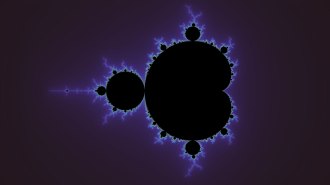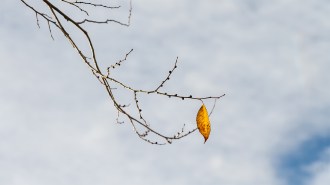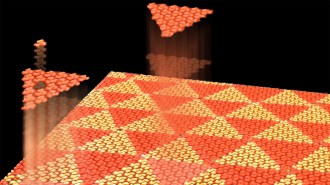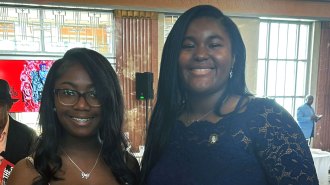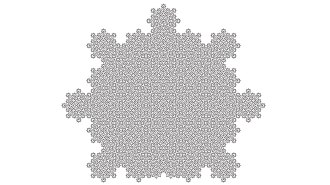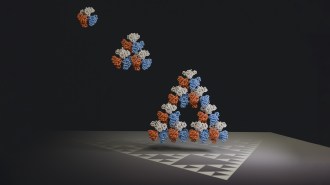The proof of a mathematical conjecture–even one as famous as Fermat’s last theorem–may sound like an improbable subject for an off-Broadway-style musical.

Yet there’s plenty of drama and passion in the story of Fermat’s last theorem. These elements take center stage in Fermat’s Last Tango, a musical written by the husband-and-wife team Joshua Rosenblum and Joanne Sydney Lessner. Originally performed by the York Theatre Company in New York City in December 2000, the production lives on as a video available from the Clay Mathematics Institute (see http://www.claymath.org/events/fermatslasttango.htm).
First proposed by French jurist and mathematician Pierre de Fermat (1601–1665), the conjecture started out as a note scrawled in the margin of a mathematics book. Translated from Latin into English, it reads:
To divide a cube into two other cubes, a fourth power or in general any power whatever into two powers of the same denomination above the second is impossible, and I have assuredly found an admirable proof of this, but the margin is too narrow to contain it.
A century after Fermat’s death and the publication of his teasing annotation, Leonhard Euler (1707–1783) proved that Fermat’s conjecture is true for n = 3. Mathematicians later found proofs for other special cases. The general case, however, eluded them.
In the late 1980s, Andrew Wiles, a mathematician at Princeton University, started to work on aspects of number theory closely related to Fermat’s last theorem. His approach relied heavily on recently discovered links between Fermat’s conjecture and the theory of so-called elliptic curves.
By assuming that Fermat’s last theorem is false, mathematicians could construct a weird elliptic curve that they believed, for other mathematical reasons, shouldn’t exist. Moreover, the existence of the strange curve would also contradict the Taniyama-Shimura conjecture, which links elliptic curves and objects known as modular forms. Hence, if proving certain aspects of the Taniyama-Shimura conjecture excluded the strange curve, this would establish the validity of Fermat’s last theorem.
Wiles took on the extremely challenging, highly technical task of proving the Taniyama-Shimura conjecture itself. He proceeded in such secrecy that even his closest acquaintances and colleagues were unaware of the extent of his determined effort.
When Wiles was finally ready to reveal that he had proved a significant portion of the Taniyama-Shimura conjecture, he described his results at a workshop at the University of Cambridge in England. Near the end of the third of three lectures, almost as an afterthought, Wiles noted that he had proved enough of the Taniyama-Shimura conjecture to show that Fermat’s last theorem is true. His surprise announcement on June 23, 1993, stunned the mathematics community.
By following a course that built on previous, well-understood results, and because of his own reputation for being extremely cautious and careful in his mathematical work, Wiles immediately earned a great deal of respect for his proof. Nonetheless, the details of Wiles’s proof, running to more than 200 manuscript pages, had to be checked thoroughly by experts. There was always a chance that his argument had some subtle flaw.
Copies of Wiles’s preliminary manuscript were sent to about half a dozen mathematicians for checking. That fall, the process of smoothing out and filling in the technical details of Wiles’s celebrated result turned up a troublesome gap in the proof’s logic.
Finding a way to fill in the hole took up much of Wiles’s time. Finally, in a rare public lecture in May 1994, a visibly relaxed Wiles explained that he believed the obstacle was surmountable–that he understood the problem well enough to see its connection with something already known in mathematics.
By November, Wiles was certain that he had bridged the gap. He went back to an approach he had tried several years earlier but had abandoned. Later, Wiles would describe this insight as “the most important moment” of his working life. “It was so indescribably beautiful, it was so simple and elegant, and I just stared in disbelief for 20 minutes,” he recalled.
Aided by Cambridge mathematician Richard Taylor, Wiles succeeded in establishing the conditions he needed to complete the proof. Wiles’s logic was now solid and his triumph complete.
Fermat’s Last Tango focuses on the traumatic period between the discovery of the flaw and its final resolution. The musical’s protagonist, fictional character Daniel Keane (who stands in for Wiles), must confront the possibility of failure. Riddled with doubt, taunted by a mean-spirited Fermat, and haunted by a ghostly chorus of Carl Friedrich Gauss, Pythagoras, Euclid, and Isaac Newton, Keane returns to his singular, possibly ill-fated pursuit. He retreats to the attic, withdrawing from his wife and leaving her again the “math widow” she had been for so many years before.
The musical is cheerful, clever, and entertaining. Its varied music is engaging. It puts mathematics on display as an intensely human endeavor.
For anyone familiar with the subject, it’s also fun to listen for the numerous mathematical and historical references that lace the lyrics. Indeed, the mathematical vocabulary, even in passing, is surprisingly sophisticated. Imagine a song in which you hear the words “Taniyama-Shimura conjecture” not just once but several times!
Pursuing Poincaré
Watching Fermat’s Last Tango called to mind a recent flurry of attention paid to the purported proof of another famous question in mathematics–the Poincaré conjecture, an important problem in the field of topology.
Topology concerns the fundamental properties of structures and spaces (including surfaces). From a topologist’s viewpoint, a sphere, for example, is still a sphere whether it is stretched, twisted, compressed, or deformed in any number of ways, as long as it isn’t punctured or torn. Similarly, a topologist sees a doughnut and a coffee mug as the same type of object because it’s possible to imagine how each of them can be massaged into the other’s shape. But a doughnut and a sphere belong to different families.
Topologists use the term “manifold” to describe any of the surfaces and spaces of greatest interest to them, and they have long sought to identify all possible manifolds. The surface of a basketball–a so-called 2-sphere–is an example of a two-dimensional manifold (or 2-manifold).
By the end of the 19th century, mathematicians had completed the classification of all 2-manifolds. Moreover, they could prove that a 2-sphere, no matter how disguised its shape may be, is really a 2-sphere (that is, a “simply connected” 2-manifold).
In 1904, Henri Poincaré (1854–1912) proposed that what was true in two dimensions also held in three dimensions. In effect, any object that mathematically behaves like a 3-sphere is topologically a 3-sphere, no matter how distorted or twisted its shape may be.
Although the statement sounds obvious, the difficulty lies in the enumeration of all the different ways in which a standard 3-sphere can be stretched and molded into some sort of manifold.
Intriguingly, mathematicians have now proved that Poincaré’s conjecture holds in every dimension greater than three. The case for 3-spheres–Poincaré’s original conjecture–remains unresolved.
Earlier this year, word began to circulate widely that Martin Dunwoody of Southampton University in England had finally solved the problem. His Web page at http://www.maths.soton.ac.uk/staff/Dunwoody/ points to a paper outlining his approach–one inspired by a “beautiful” algorithm of J. Hyam Rubinstein of the University of Melbourne for recognizing the 3-sphere.
Although Dunwoody is a respected mathematician, there is considerable skepticism in the mathematics community that he has truly solved the problem. Indeed, cognizant of the many false “proofs” of the conjecture that have been proffered in the past, mathematicians have approached the new claim warily.
One instructive instance of a past failure occurred in 1986. In March of that year, Colin Rourke and his student Eduardo Rgo announced that they had proved the Poincaré conjecture. Rourke was so sure that the proof was legitimate that he took an unusual step for a mathematician and announced the results in a press release and, later that year, wrote an article about the proof for a popular science magazine.
Meanwhile, most mathematicians keenly interested in the question remained silent and simply waited for better evidence. Some resented the fact that Rourke had publicized his achievement without waiting for verification. Normally, mathematicians quietly pass their manuscripts to their friends and colleagues for comment. Only months or years later, after the mathematical community has finally applied its stamp of approval, is the work published in a mathematical journal, and the public may then hear of the result.
The biggest problem in verifying the purported proof, which ran to dozens of pages in manuscript form, was to find mathematicians willing to take the time from their own work. If a mistake happened to be buried in the argument’s details, the task of checking the proof could take months of effort.
In November 1986, Rourke was at the University of California, Berkeley, conducting a seminar to explain and defend his proof. By the end of the week, Rourke’s audience, which included some of the world’s top topologists, had pointed out a gap in his proof, one that Rourke could not fill. In the end, there was no valid proof.
What will happen in Dunwoody’s case isn’t clear yet. The jury is still out and may indeed be absent for some time to come. It takes time to verify every detail of a proposed proof, especially for such an important, longstanding mathematical problem.
Moreover, in this case, there is a prize of $1 million at stake. Offered by the Clay Mathematics Institute, the sum would be awarded only after “a proposed solution. . . [is] published in a refereed mathematics journal of worldwide repute, and it must also have general acceptance in the mathematics community two years after.”
The business of mathematical proof is indeed a serious one. In the hands of a talented composer and clever lyricist, it is also an entertaining one.
